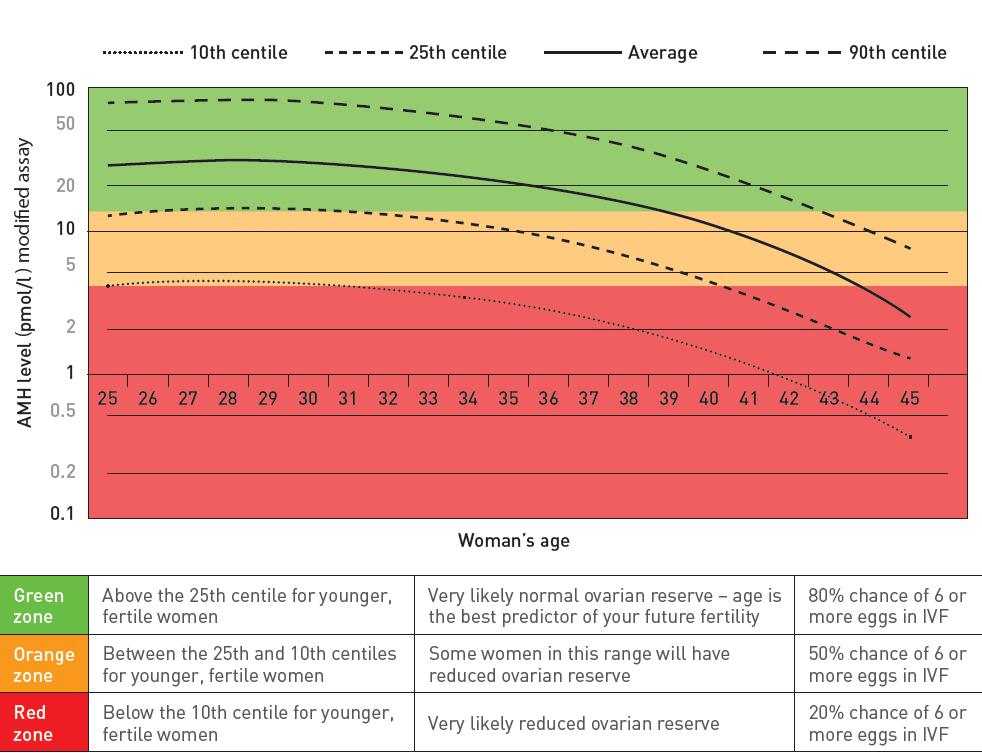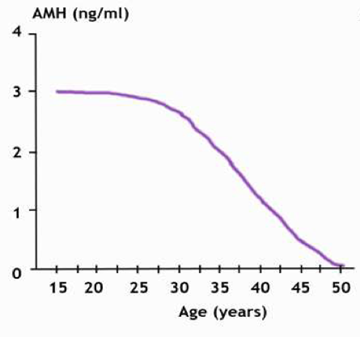About the AMH Test
The Anti-Mullerian Hormone (AMH) test is the best test currently available to estimate ovarian reserve, and indicate the possibility of early fertility loss. However, it cannot show who is more fertile than average, nor does it predict ovarian reserve in women with Polycystic Ovaries (PCOs).
- It is a single blood test that can be done at any time during the menstrual cycle.
- It can also help predict how many eggs you are likely to obtain in an IVF cycle.
- It may also identify women who may undergo early menopause, and therefore who may lose their fertility earlier than average.
If you would like to have your AMH test done, please contact us. We recommend an appointment with a fertility specialist to analyse the results, and to explain what they mean for you. The interpretation of the AMH result will depend on your medical history, your family’s fertility history, lifestyle and other investigations into your fertility.
Interpreting AMH
Like most fertility tests, an AMH test does not give a black and white answer.
- We plot the AMH result on a graph (see below) that shows the 25th to 75th percentiles for AMH for women attending a fertility clinic.
- This lets you compare your results with women of a similar age and helps predict how your AMH level may change over the years.
- We have shaded areas of the graph red, orange and green to represent the impact of your AMH level for your age.
More info can be found on the blog by Dr Lim “Is My AMH Too High or Too Low?”

Normal AMH
In recent years, several graphs for normal levels of AMH from birth to menopause have been developed. Collectively, the studies show that AMH is low during pre-pubertal development, rises during early puberty, and plateau at 20-25 years of age. After which, AMH gradually declines and becomes undetectable around menopause.
It is not yet understood why AMH rises during childhood and adolescence. Hence, AMH can only be used to assess the extent of ovarian aging in women above 25 years of age. 
High AMH
When AMH exceeds 48pmo/L, it may indicate that the woman might be suffering from Polycystic Ovarian Syndrome (PCOS).
- PCOS is the most common hormonal disturbance affecting about 10% of reproductive-age women.
- It is also one of the commonest causes of subfertility.
- Due to hormonal imbalances, they are unable to produce a dominant follicle regularly which leads on to irregular and infrequent ovulation.
- This results in many underdeveloped and immature eggs. These eggs, within the follicles, produce AMH. Hence, women with PCOS have an excess of AMH.
Low AMH
Low AMH indicates a lower number of eggs (follicles), often termed low ovarian reserve. It is important to read AMH in the context of many factors, most importantly your age.
- Women are said to have diminished ovarian reserve (DOR) when the number of eggs is much lower than expected for women the same age.
- When this happens, your doctor might get you to perform some genetic screening such as Fragile X Syndrome.
- Other causes of DOR are smoking, endometriosis, pelvic inflammatory disease, ovarian surgery, autoimmune diseases, and cancer treatment.
In many cases, no apparent cause can be identified. If a woman experience menopause before the age of 40, they have Premature Ovarian Insufficiency (POI), which impacts 1in 100 women.
Women with POI can experience symptoms such as irregular periods, typically shortening of menstrual cycles well in their 30s.
How about the Quality of Eggs?
AMH does not tell us about the quality of eggs, which is important when it comes to getting pregnant. Fertility is directly related to egg quality, unfortunately, there is no test for it. Age is the best predictor as quality declines in a predictable manner with age.
The only way to test is to attempt fertilisation of the eggs then perform a test on the resulted embryos for chromosomal abnormalities.
- Women in their 20s have mostly (80%) normal eggs, although they too have abnormal ones.
- Whereas women in their 40s have mostly (80%) abnormal eggs, regardless of how healthy they have been.
To illustrate further,
- AMH of 7 pmol/L is low for 32 years old but it is within the normal range for a 42-year-old woman.
- They may yield similar number of eggs during IVF treatment, but 32 year old will have better chance of success with IVF as the proportion of normal eggs is higher with younger eggs.
- Our chances at pregnancy is significantly tied to the age of the eggs, which is the basis of the process.
The basics of women's fertility: The 3As
Women are born with all the eggs that they will ever have. In fact, by the time a female infant is born, still many years from reproductive potential, the number of eggs in her ovaries has already declined by 80% from the peak number of eggs. The number gets even smaller by the time a girl enters puberty and begins to menstruate.
When a woman is trying to conceive, it helps to have regular ovulatory cycles that produces good quality eggs. How does age affect fertility in both men and women, especially that of the women? Firstly, as women age, the pool of eggs gets smaller and smaller, making it less likely for ovulation to occur regularly, which will lead to irregular cycles and ultimately menopause. Secondly, the process of meiosis (division of reproductive cells) is more prone to errors while we age. This results in lesser quality eggs which is also the reason why older women have higher risk of having a baby with chromosomal abnormality.
To put this into perspective, women’s fertility starts to decline from age of 30, and drops more steeply after the age of 35. This is because women are born with a finite number of eggs, and as she grows older so does the eggs, both in quantity and quality. Most women will be able to conceive naturally and give birth to a healthy baby if they get pregnant by 35.
After 35, the proportion who experience infertility, miscarriage or a problem with the baby increases. Therefore, from a pure biological perspective, it is best to try to start a family before you are 35. On the other hand, men can remain fertile for much longer than women. Even though male fertility also declines with age, it tends to happen more gradually.
Read the Blog about Age, AMH and Antral Follicle Count

